43.1 Calculate the energy of a He+ ion in its first excited state.
Sol. ![]()
For a He+ ion, Z = 2 and for the first excited state, n = 2 so that the energy of He ion in the first excited state is – 13.6 eV.
43.2 Calculate the wavelength of radiation emitted when He+ makes a transition from the state n = 3 to the state n = 2.
Sol. The wavelength l is given by
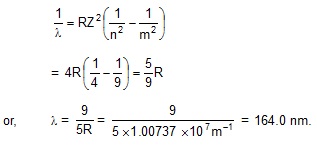
43.3 The excitation energy of hydrogen-like ion in its first excited state in 40.8 eV. Find the energy needed to remove the electron from the ion.
Sol. The excitation energy in the first excited state is

Equating this to 40.8 eV, we get Z = 2. So, the ion in question is He+. The energy of the ion in the ground state is

Thus 54.4 eV is required to remove the electron from the ion.
1. How many wavelengths are emitted by atomic hydrogen in visible range (380 nm – 780 nm)? In the range 50 nm to 100 nm ?
2. The first excited energy of a He+ ion is the same as the ground state energy of hydrogen. Is it always true that one of the
energies of any hydrogen-like ion will be the same as the ground state energy of a hydrogen atom ?
3. Which wavelengths will be emitted by a sample of atomic hydrogen gas (in ground state) if electrons of energy
12.2 eV collide with the atoms of the gas ?
4. When white radiation is passed through a sample of hydrogen gas at room temperature, absorption lines are
observed in Lyman series only. Explain.
5. Balmer series was observed and analysed before the other series. Can you suggest a reason for such an order?
6. What will be the energy corresponding to the first excited state of a hydrogen atom if the potential energy of the atom is taken
to be 10 eV when the electron is widely separated from the proton? Can we still write widely separated from the proton? Can we still write En = E1/n2? rn = a0 n2?
7. The difference in the frequencies of series limit of Lyman series and Balmer series is equal to the frequency of the first line of the Lyman series.. Explain.
8. The numerical value of ionization energy in eV equals the ionization potential in volts. Does the equality hold if these quantities are measured in some other units?
9. We have stimulated emission and spotaneous emission. Do we also have stimulated absorption and spontaneous absorption?
10. An atom is in its excited state. Does the probability of its coming to ground state depend on whether the radiation
is already present or not? If yes, does it also depend on the wavelength of the radiation present?
Objective - I
1. The minimum orbital angular momentum of the electron in a hydrogen atom is -
(A) h (B) h/2 (C*) h/2p (D) h/l
2. Three photons coming from excite3d atomic-hydrogen sample are picked up. Their energies are 12.1 V, sample 10.2eV and 1.9eV. These photons must come from
(A) a single atom (B) two atoms (C) three atom
(D) either two atoms or three atoms
3. Suppose, the electron in a hydrogen atom makes transition from n = 3 to n = 2 in 10–8 s. The order of the torque acting on the electron
in this period, using the relation between troque and angular momentum as discussed in the chapter on rotational mechanics is
(A) 10-34 N-m (B*) 10-24 N-m (C) 10-42 N-m (D) 10-8 N-m
4. In which of the following transitions will the wavelength be minimum ?
(A) n = 5 to n = 4 (B) n = 4 to n = 3 (C) n = 3 to n = 2 (D*) n = 2 to n = 1
5. In which of the following systems will the radius of the first orbit (n=1) be minimum ?
(A) hydrogen atom (B) deuterium atom
(C) singly ionized helium (D) doubly ionized lithium
6. In which of the following systems will the wavelength corresponding to n=2 to n=1 be minimum ?
(A) hydrogen atom (B) deuterium atom
(C) singly ionized helium (D) doubly ionized lithium
7. Which of the following curves may represent the speed of the electron in a hydrogen atom as a function of the principal quantum number ?

8. As one considers orbits with higher values of n in a hudrogen atom, the electric potential energy of the atom
(A) decreases (B*) increases (C) remains the same (D) does not increase
9. The energy of an atom (or ion) in its ground state is - 54.4eV. It may be
(A) hydrogen (B) deuterium (C*) He (D) Li
10. The radius of the shortest orbit in a one-electron system is 18 pm. It may be
(A) hydrogen (B) deuterium (C) He (D*) Li
11. A hydrogen atom in ground state absorbs 10.2eV of energy. The orbital angular momentum of the electron is increased by
(A*) 1.05 x 10 -34 J-s (B) 2.11 x 10 -34 J-s (C) 3.16 x 10 -34 J-s (D) 4.22 x 10 -34 J-s
12. Which of the following parameters are the same for all hydrogen-like atoms and ions in their ground states ?
(A) radius of the orbitq (B) speed of the electron
(C) energy of the atom (D) orbital angular momentum of the electron
13. In a laser tube, all the photons
(A) have same wavelength (B) have same energy
(C) move in same direction (D) move with same speed
Objective - II
1. In a laboratory experiment on emission from atomic hydrogen in a discharge tube, only a small number of lines are
abserved whereas a large number of lines are present in the hydrogen spectrum of a star. This is because in a laboratory
(A) the amount of hydrogen taken in much smaller than that present in the star.
(B) the temperature of hydrogen is much smaller than that of the star
(C) the pressure of hydrogen is much smaller than that of the star
(D) the gravitational pull is much smaller than that in the star.
2. An electron with kinetic energy 5 eV is incident on a hydrogen atom in its ground state. The collision
(A) must be elastic (B) may be partially elastic
(C) must be completely inelastic (D) may be completely inelastic
3. Which of the following products in a hydrogen atom are independent of the principal quantum n ? The symbols have their usual meanings
(A) un (B) Er (C) En (D) ur
4. Let An be the area enclosed by the nth orbit in a hydrogen atom. The graph of ln (An / A1) against ln (n)
(A) will pass through the origin (B) will be a straight line with slope 4
(C) will be a monotonically increasing nonlinear curve (D) will be a circle

5. Ionization energy of a hydrogen-like ion B. Let r, u, E and L represent the radius of the orbit, speed of the electron,
energy of the atom and orbital angular momentum of the electron respectively. In ground state
(A) rA > rB (B*) uA > uB (C) EA > EB (D) LA > LB
6. When a photon stimulates the emission of another photon, the two photons have
(A*) same energy (B*) same direction (C*) same phase (D*) same wavelength
Worked Out Examples
1. Find the radius of Li++ ions in its ground state assuming Bohr’s model to be valid.
cksgj ds ekWMy dks lR; ekurs gq, Li++ vk;u dh f=kT;k dh x.kuk dhft,A HCV_Ch-43_WOE_1
Sol. For hydrogen -like ions, the radius of the nth orbit is
![]()
For Li++, Z = 3 and in ground state n = 1. The radius is
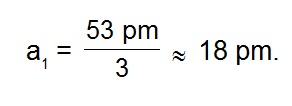
2. A particular hydrogen-like ion emits radiation of frequency 2.467 × 1015 Hz when it makes transition from
n = 2 to n = 1. What will be the frequency of the radiation emitted in a transition from n = 3 to n = 1?
Sol. The frequency of radiation emitted is given by
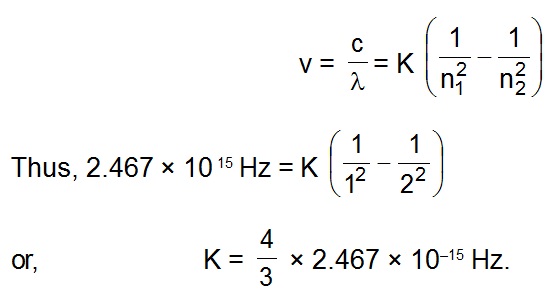
The frequency of the radiation emitted in the transition n = 3 to n = 1 is
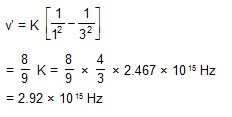
3. Calculate the two highest wavelengths of the radiation emitted when hydrogen atoms make transitions from higher states to n = 2 states.
Sol. The highest wavelength corresponds to the lowest energy of transition. This will be the case for the transition n = 3 to n = 2.
The second highest wavelength corresponds to the transition n = 4 to n = 2.
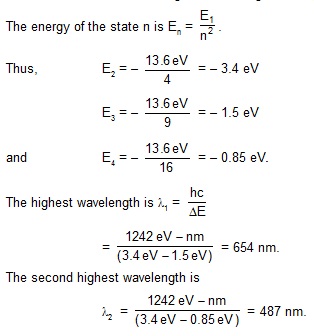
4. What is the wavelength of the radiation emitted when the electron in a hydrogen atoms jumps from n = ¥ to n = 2?
Sol. The energy of n = 2 state is

The wavelength emitted in the given transition is
![]()
5. (a) Find the wavelength of the radiation required to excite the electron in Li++ from the first to the third Bohr orbit.
(b) How many spectral linea are observed in the emission spectrum of the above excited system?
Sol. (a) The energy in the first orbit = E1 = Z2 E0 where E0 = – 13.6 eV is the energy of a hydrogen atom in ground state thus for Li++,
E1 = 9E0 = 9 × (– 13.6 eV).
The energy in the third orbit is

The wavelength of radiation required to excite Li++ from the first orbit to the third orbit is given by

The wavelength of radiation required to excite Li++ from the first orbit to the third orbit is given by
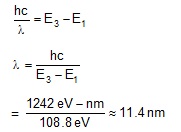
(b) The spectral lines emitted are due to the transitions n = 3 ® n = 2, n = 3 ® n = 1 and
n = 2 ® n = 1. Thus, there will be three spectral lines in the spectrum.
6. Find the wavelengths present in the radiation emitted when hydrogen atoms excited to n = 3 states return to their ground states.
Sol. A hydrogen atom may return directly to the ground state or it may go to n = 2 and from there to the ground state. Thus,
wavelengths corresponding to n = 3 ® n = 1, n = 3 ® n = 2 are present in the radiation.
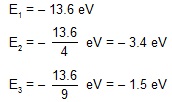
The wavelength emitted in the transition n = 3 to the ground state is

Similarly, the wavelength emitted in the transition n = 3 to n = 2 is 654 nm and that emitted in the transition n = 2 to n = 1 is 122 nm.
The wavelengths present in the radiation are, therefore, 103 nm, 122 nm and 654 nm.
7. How may different wavelengths may be observed in the spectrum from a hydrogen sample if the atoms are excited to
states with principal quantum number n ?
Sol. From the nth state, the atom may go to (n – 1)th state, ...., 2nd state or 1st state. So there are
(n – 1) possible transitions starting from the nth state. The atoms reaching (n – 1)th state may make (n – 2) different transitions.
Similarly for other lower states. The total number of possible transitions is
(n – 1) + (n – 2) + (n – 3) +............2 + 1
![]()
8. Monochromatic radiation of wavelength l is incident on a hydrogen sample in ground state. Hydrogen atoms absorb a fraction
of light and subsequently emit radiation of six different wavelengths. Find the value l
Sol. As the hydrogen atoms emit radiation of six different wavelengths, some of them must have been excited to n = 4. The energy in n = 4 state is
![]()
The energy needed to take a hydrogen atom from its ground state to n = 4 is
13.6 eV – 0.85 eV = 12.75 eV
The photons of the incident radiation should have 12.75 eV of energy. So,

9. The energy needed to detach the electron of a hydrogen–like ion in ground state is 4 rydberg. (a) What is the wavelength of the
radiation emitted when the electron jumps from the first excited state to the ground state ? (b) What is the radius of the first orbit for this atom ?
Sol. (a) In energy units, 1 rydberg = 13.6 eV. The energy needed to detach the electron is 4 × 13.6 eV. The energy in the ground state is, therefore,
E1 = –4 × 13.6 eV. The energy of the first excited state (n = 2) is ![]() 13.6 eV = 40.8 eV. The wavelength of the radiation emitted is
13.6 eV = 40.8 eV. The wavelength of the radiation emitted is
![]()
(b) The energy of a hydrogen-like ion in ground state is E = Z2E0 where Z = atomic number and E0 = – 13.6

10. A hydrogen sample is prepared in a particular excited state A. Photons of energy 2.55 eV get absorbed into the sample to take some
of the electrons to a further excited state B. Find the quantum numbers of the states A and B.
Sol. The allowed energies of hydrogen atoms are
E1 = – 13.6 eV
E2 = –3.4 eV
E3 = –1.5 eV
E4 = –0.85 eV
E5 = – 0.54 eV
We see that a different of 2.55 eV can only be absorbed in transition n = 2 to n = 4. So the state A has quantum number 2 and the state B has quantum number 4.
11. (a) Find the maximum wavelength l0 of light which can ionize a hydrogen atom in its ground state. (b) Light of wavelength l0 is incident on a hydrogen
atom which is in its first excited state. Find the kinetic energy of the electron coming out.
Sol. (a) To ionize a hydrogen atom in ground state, a minimum of 13.6 eV energy should be given to it. A photon of light should have this much of energy
in order to ionize a hydrogen atom. Thus,
![]()
![]()
(b) The energy of the hydrogen atom in its first excited state is =![]() Thus,
Thus,
3.4 eV of energy is needed to take the electron out of the atom. The energy of a photon of the light of wavelength l0 is 13.6 eV. Thus, the electron coming
out will have a kinetic energy 13.6 eV – 3.4 eV = 10.2 eV.
12. Derive an expression for the magnetic field at the site of the nucleus in a hydrogen atom due to the circular motion of the electron.
Assume that the atom is in its ground state and give the answer in terms of fundamental constants.
Sol. We have

From Bohr’s quantization rule, in ground rule, in ground state,
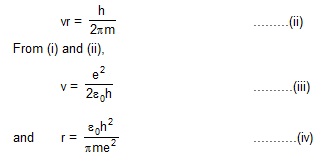
As the electron moves along a circle, it crosses any point on the circle![]() times per unit time.
times per unit time.
The charge crossing per unit time, that is the current, is![]() .
.
The magnetic field at the centre due to this circular current is
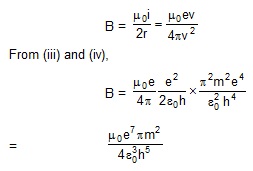
13. A lithium atom has three electrons, Assume the following simple picture of the atom. Two electrons move close to the nucleus making up
a spherical cloud around it and the third moves outside this cloud in a circular orbit. Bohr’s model can be used for the motion of this third
electron but n = 1 states ar not available to it. Calculate the ionization energy of lithium in ground state using the above picture.
Sol. In this picture, the third electron moves in the field of a total charge + 3e – 2e = + e. Thus, the energies are the same as that of hydrogen atoms.
The lowest energy is :
![]()
Thus, the ionization energy of the atom in this picture is 3.4 eV.
14. A particle known as m-meason, has a charge equal to that of an electron and mass 208 times the mass of the electron. It moves in a circular
orbit around a nucleus of charge +3e. Take the mass of the nucleus to be infinite. Assuming that the Bohr’s model is applicable to this system,
(a) derive an expression for the radius of the nth Bohr orbit, (b) find the value of n for which the radius of the orbit is approximately the same as
that of the first Bohr orbit for a hydrogen atom and (c) find the wavelength of the radiation emitted when the m–meson jumps from the third
orbit to the first orbit.
Sol. (a) We have,

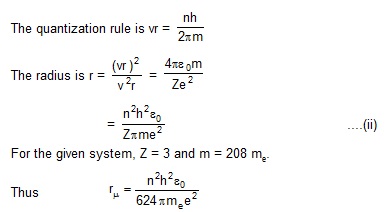
(b) From (ii), the radius of the first Bohr orbit for the hydrogen atom is
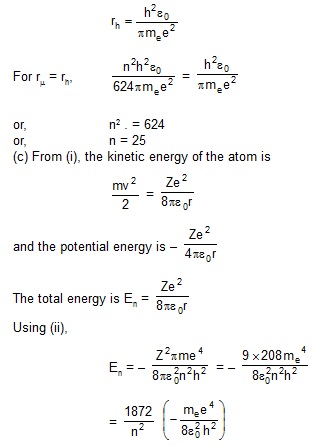

The wavelength emitted is
![]()
15. Find the wavelengths in a hydrogen spectrum between the range 500 nm to 700 nm.
Sol. The energy of a photon of wavelength 500 nm is
![]()
The energy difference between the states involved in the transition should, therefore, be between 1.77 eV and 2.44 eV.

Figure shows same of the energies of hydrogen states. It is clear that only those transitions which end at n = 2 may emit photons of
energy between 1.77 eV the proper range. The energy of the photon emitted in the transition n = 3 to n = 2 is DE = (3.4 – 1.5) eV = 1.9 eV.
The wavelength is
![]()
16. A beam of ultraviolet radiation having wavelength between 100 nm and 200 nm is incident on a sample of atomic hydrogen gas.
Assuming that the atoms are in ground state, which wavelength will have low intensity in the transmitted beam? If the energy of
a photon is equal to the difference between the energies of an excited being absorbed by an atom in the ground state.
Sol. The energy of a photon corresponding to l = 100 nm is
![]()
and that corresponding to l = 200 nm is 6.21 eV.
The energy needed to take the atom from the ground state to the first excited state is
E2 – E1 = 13.6 eV – 3.4 eV = 10.2 eV,
to the second excited state is
E3 – E1 = 13.6 eV – 1.5 eV = 12.1 eV.
to the third excited state is
E4 – E1 = 13.6 eV – 0.85 eV = 12.75 eV etc.
Thus, 10.2 eV photons and 12.1 eV photons have large probability of being absorbed from the given range 6.21 eV to 12.42 eV.
The corresponding wavelengths are

These wavelengths will have low intensity in the transmitted beam.
17. A neutron moving with speed v makes a head-on collision with a hydrogen atom in ground state kept at rest. Find the minimum
kinetic energy of the neutron for which inelastic (completely or partially) collision may take place. The mass of neutron = mass
of hydrogen = 1.67 × 10–27 kg.
Sol. Suppose the neutron and the hydrogen atom move at speed v1 and v2 after the collision. The collision will be inelastic if a part
of the kinetic energy is used to excite the atom. Suppose an energy DE is used in this way. Using conservation of linear momentum and energy.

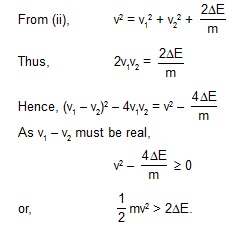
The minimum energy that can be absorbed by the hydrogen atom in ground state to go in an excited state is 10.2 eV. Thus,
the minimum kinetic energy of the neutron needed for an inelastic collision is
![]()
18. Light corresponding to the transition n = 4 to n = 2 in hydrogen atoms falls on cesium metal (work function = 1.9 eV).
Find the maximum kinetic energy of the photoelectrons emitted.
Sol. The energy of the photons emitted in transition n = 4 to n = 2 is

19. A small particle of mass m moves in such a way that the potential energy![]() where w is a constant and r
where w is a constant and r
is the distance of the particle from the origin. Assuming Bohr’s model of quantization of angular momentum and
circular orbits, show that radius of the nth allowed orbit is proportional to .
Sol. The force at a distance r is
![]()
Suppose the particle moves along a circle of radius r. The net force on it should be mv2/r along the radius.
Comparing with (i),

The quantization of angular momentum gives

Thus, the radius of the nth orbit is proportional to .
Exercise
1. The Bohr radius is given by  Verify that the RHS has dimensions of length.
Verify that the RHS has dimensions of length.
Ans :
2. Find the wavelength of the radiation emitted by hydrogen in the transitions (a) n = 3 to n = 2, (b)n = 5 to n = 4 and (c) n = 10 to n = 9.
Ans: (a) 654 nm (b) 4050 nm (c) 38860
3. Calculate the smallest wavelength of radiation that may be emitted by (a) hydrogen, (b) He + and
(c) Li++
Ans: (a) 91 nm (b) 23 nm (c) 10 nm
4. Evaluate Rydberg constant by putting the values of the fundamental constants in its expression.
Ans : 1.097 × 10 7 m – 1
5. Find the binding energy of a hydrogen atom in the state n = 2.
Ans : 3.4 eV
6. Find the radius and energy of a He+ ion in the states (a) n = 1, (b) n = 4 and (c) n = 10.
Ans : (a) 0.265 A, – 54.4 eV (b) 4.24 A ,– 3.4 eV
7. A hydrogen atom emits ultraviolet radiation of wavelength 102.5 nm. What are the quantum numbers of the states involved in the transition ?
Ans : 1 and 3
8. (a) Find the first excitation potential of He+ ion (b) Find the ionization potential of Li++ ion.
Ans : (a) 40.8 V (b) 122.4 V
9. A group of hydrogen atoms are prepared in n = 4 states. List the wavelength that are emitted as the atoms make transitions and return to n = 2 states .
Ans : 487 nm, 654 nm 1910 nm
10. A positive ion hydrogen just one electron ejects it if a photon of wavelength 228 Å of less is absorbed by it identify the ion.
Ans : He +
11. Find the maximum coulomb force that can act on the electron due to the nucleus in a hydrogen atom.
Ans: 8.2 × 10 – 8 N
12. A hydrogen atom in a state having a binding energy of 0.85 eV makes transition to a state with excitation energy 10.2 eV
(a) identify the quantum numbers n of the upper and the lower energy states involved in the transition.
(b) Find the wavelength of the emitted radiation.
Ans: (a) 4, 2 (b) 487 nm
13. Whenever a photon is emitted by hydrogen in Balmer series it is followed by another photon in Lyman series. What wavelength does this latter photon correspond to ?
Ans: 122 nm
14. A hydrogen atom in stage n = 6 makes two successive transitions and reaches the ground state. In the first transition a photon of 1.13 eV is emitted in the second transition
(b) What is the value of n in the intermediate state?
Ans: 121.eV , 3
15. What is the energy of a hydrogen atom in the first excited state if the potential energy is taken to be zero in the ground state ?
Ans: 23.8 eV
15. What is the energy radiation of wavelengths 46.0 nm, 82.8 nm and 103.5 nm only. Assume that the atoms have only two excited states and the
difference between consecutive energy levels decreases as energy is increased. Taking the energy of the highest energy state to be zero,
find the energies of the ground state and the first excited state.
16. A hot gas emits radiation of wavelengths 46.0 nm 82.8 nm and 103.5 nm only. Assume that the atoms have only two excited states and
the difference between consecutive energy levels decreases as energy is increased. Taking the energy of the ground state and the first excited state.
Ans: – 27 eV , – 12 eV
17. A gas of hydrogen like ions is prepared in a particular excited state A it emits photons having wavelength equal to the wavelength of the first line
of the lyman series together with photons of five other wavelength identify the gas and find the principal quantum number of the state A.
Ans: He + 4,
18. Find the maximum angular speed of the electrons of a hydrogen atom in a stationary orbit.
Ans: 4.1 × 10 16 rad/s
19. A spectroscopic instrument can resolve two nearby wavelength l and l + D l id l/Dl is smaller than 8000 .This is used to study the spectral lines
of the Balmer series of hydrogen Approximately how many lines will be resolved by the instrument ?
Ans: 38
20. Suppose in certain conditions only those transitions are allowed to hydrogen atoms in which the principal quantum number n change by 2
(a) Find the smallest wavelength emitted by hydrogen (b) List the wavelengths emitted by hydrogen in the visible range (380 nm to 780)
Ans: (a) 103 nm (b) 487 nm
21. According to Maxwell’s theory of electrodynamics an electrons going in a circle should emit radiation of frequency equal to its frequency of revolution .
What should be the wavelengths of the radiation emdiation by a hydrogen atom in ground state if this rule is followed ?
Ans: 45.7nm
22. The average lometic energy of molecules in a gas at temperature T is KT .Find the temperature at which the average kinetic energy of the molecules
of hydrogen equals the binding energy of its atoms will hydrogen remain in molecular form at this temperature ?Take K = 8.62 × 10–5 eV/K
Ans: 1.05 × 10 5 K
23. Find the temperature at which the average thermal kinetic energy is equal to the energy needed to take a hydrogen atom from its ground state to n = 3 state.
Hydrogen can now emit red light of wavelengths 653.1nm Because of Maxwellian distributions of speeds, a hydrogen sample emits red light at temperature
much lower than that obtained from this problem. Assume that hydrogen molecules dissociate into atoms.
Ans: 9.4 × 10 4 K
24. Average lifetime of a hydrogen atom excited n = 2 state is 10– 8 s. Find the number of revolutions made by the electrons on the average before it jumps to ground state.
Ans: 8.2 × 10 6
25. Calculate the magnetic dipole moment corresponding to the motion of the electrons in the ground state of a hydrogen atom.
Ans: 9.2 × 10
26. Show that the ratio of the magnetic dipole moment to the angular momentum (l = mnr) is universal
constant for hydrogen like atoms and ions. Find its value.
Ans: ![]()
27. A beam of light having wavelengths distributed uniformly between 450 nm to 550 passes through a sample of hydrogen gas.
Which wavelength will have the least intensity in the transmitted beam ?
Ans: 487 nm
28. Radiation coming from transitions n = 2 to n = 1 of hydrogen atoms falls on helium ions in n = 1 and n =2 states.
What are the possible transitions of helium ions as they absorb energy from the radiation?
Ans: n = 2 to n = 3 and n = 2 to n = 4
29. A hydrogen atom in ground state absorbs a photon of ultraviolet radiation of wavelength 50 nm Assuming that the
entire photon energy is taken up by the electron with what kinetic energy will the electrons be ejected ?
Ans : 11.24 eV
30. A parallel beam of light of wavelength 100nm passes through a sample of atomic hydrogen gas in ground state
(a) Assume that when a photon supplies some of its energy to a hydrogen atom the rest of the energy by the excited
hydrogen atoms in the direction of the incident beam what wavelengths may be observed in the transmitted beam ?
(b) A radiation detector is placed neat the gas to detect radiation coming perpendicular to the incident beam .
Find the wavelengths of radiation that may be detected by the detector.
Ans: (a) 100 nm , 560 nm 3880 (b) 103 nm, 121 nm 654 nm
31. A beam of monochromatic light of wavelength l ejects photoelectrons from a cesium surface (f = 1.9 eV) These
photoelectrons are made to collide with hydrogen atoms in ground state .Find the maximum value of l for which
(a) hydrogen atoms may be ionised (b) hydrogen atoms may get excited from the ground state to the first excited state and
(c) the excited hydrogen atoms may emit visible light.
Ans: (a) 80 nm( (b) 102 nm (c) 89 nm
32. Electrons are emitted from an electron gun at almost zero velocity and accelerated by an electric field E through a distance of
1.0 m The electrons are now scattered by an atomic hydrogen sample in ground state. What should be the minimum value of E
so that red light of wavelength 656 .3 may be emitted by the hydrogen ?
Ans: 12.1 V/m
33. A neutron having kinetic energy 12.5 eV collides with a hydrogen atom at rest Neglect the difference in mass between the neutron
and the hydrogen atom and assume that the neutron does not leaves its line of motion Find the possible kinetic energies of the neutron after the event.
Ans: zero
34. A hydrogen atom moving at speed n colloids with another hydrogen atom kept at rest Find the minimum value of n for which one of the
atoms may get ionized the mass of a hydrogen atom = 1.67 × 10–27 kg.
Ans: 7.2 × 10 4 m/s
35. A neutron moving with a speed v strikes a hydrogen atom in ground state moving towards it with the same speed .
Find the minimum speed of the neutron for which inelastic (completely of partially) collision may get ionized
The mass of neutron = mass of hydrogen = 1.67 × 10–27kg
Ans: 3.13 × 104 m/s
36. When a photons is emitted by a hydrogen atom, the photon carries a momentum with it(a) Calculate the momentum carried
by the photon when a hydrogen atom emits light of wavelength 656.3nm
(b) With what speed does the atom recoil during this transition ?Take the mass of the hydrogen
atom =1.67 × 10 – 27 kg (c) Find the kinetic energy of recoil of the atom
Ans : (a) 1.0 × 10 27 kg m/s (b) 0.6 m/s
37. When a photon is emitted from an atom the atom recoils. The kinetic energy of recoil and the energy of the photon come
from the difference in energies between the states involved in the energies between the states involved transition suppose
a hydrogen atom changes its state from n = 3 to n = 2 Calculate the fractional change in the wavelength of light emitted,
due to the recoil
Ans: 10 – 9
38. The light emitted in the transition n = 3 to n = 2 in hydrogen is called Ha light. Find the maximum work function a metal
can have so that Ha light can emit photoelectrons from it.
Ans: 1.9 eV
39. Light from Balmer series of hydrogen is able to eject photoelectrons from a metal .What can be the maximum work function of the metal?
Ans: 3.4 eV
40. Radiation from hydrogen discharge tube falls on a cesium plate. Find the maximum possible kinetic energy of the photoelectrons .
Work function of cesium is 1.9 eV.
Ans: 11.7 eV
41. A filter transmits only the radiation of wavelength greater than 440 nm. Radiation from a hydrogen discharge tube goes through such
a filter and is incident on a metal of work function 2.0 eV Find the stopping potential which can stop the photoelectrons.
Ans: 0.55
42. The earth revolves round the sun due to gravitational attraction Suppose that the sun and the earth are point particles with their existing
masses and that Bohar ‘s quantization rule for angular momentum is valid in the case of gravitation (a) Calculate the minimum radius the
earth can have for its orbit (b) What is the value of the principal quantum number n for the present radius ?
Mass of the earth = 6.0 ×1024 kg mass of the sun 2.0 × 1030 kg earth sun distance = 1.5 × 1011m.
Ans: (a) 2.3 × 10 – 138 m (b) 2.5 × 10 74
43. Consider a neutron and an electrons bound to each other due to gravitational force .Assuming Bohar s quantization rule for angular momentum
to be valied in this case derive an expression for the energy of the neutron - electron system.
![]()
44. A uniform magnetic field B exists in a region An electron projected perpendicular to the field goes in a circle Assuming Bohar’s quantization rule
for angular momentum calculate (a) the smallest possible radius of the electron (b) the radius of the nth orbit and
(c) the minimum possible speed of the electron.
![]()
45. Suppose in an imaginary world the angular momentum is quantized to be even integral multiples of h/2p What is the longest possible wavelength
emitted by hydrogen atoms in visible range in such a world according to Bohr’s model?
Ans: 487 nm
46. Consider an excited hydrogen atom in state n moving with a velocity n (n << c ).It emits a photons in the direction of its motion and changes its
state to a lower state m Apply momentum and energy conservation principles to calculate the frequency n of the emitted radiation compare this
wite the frequency vo emitted if the atom were at rest.
